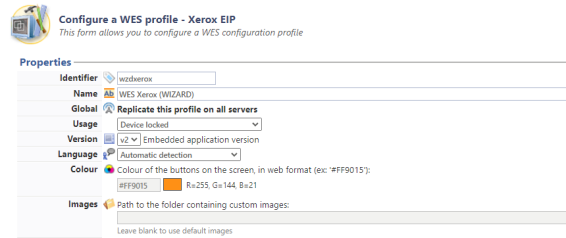Xerox WES - Create and configure the WES profile
Create the WES profile
On a clean Watchdoc installation, a first WES profile is automatically created with default parameters at the end of the wizard procedure, but you can, at any time, edit existing profiles to modify them or create a new profile.
-
From the Main menu in the administration interface;
-
in the Configuration section, click on Web, WES & Scan destinations:
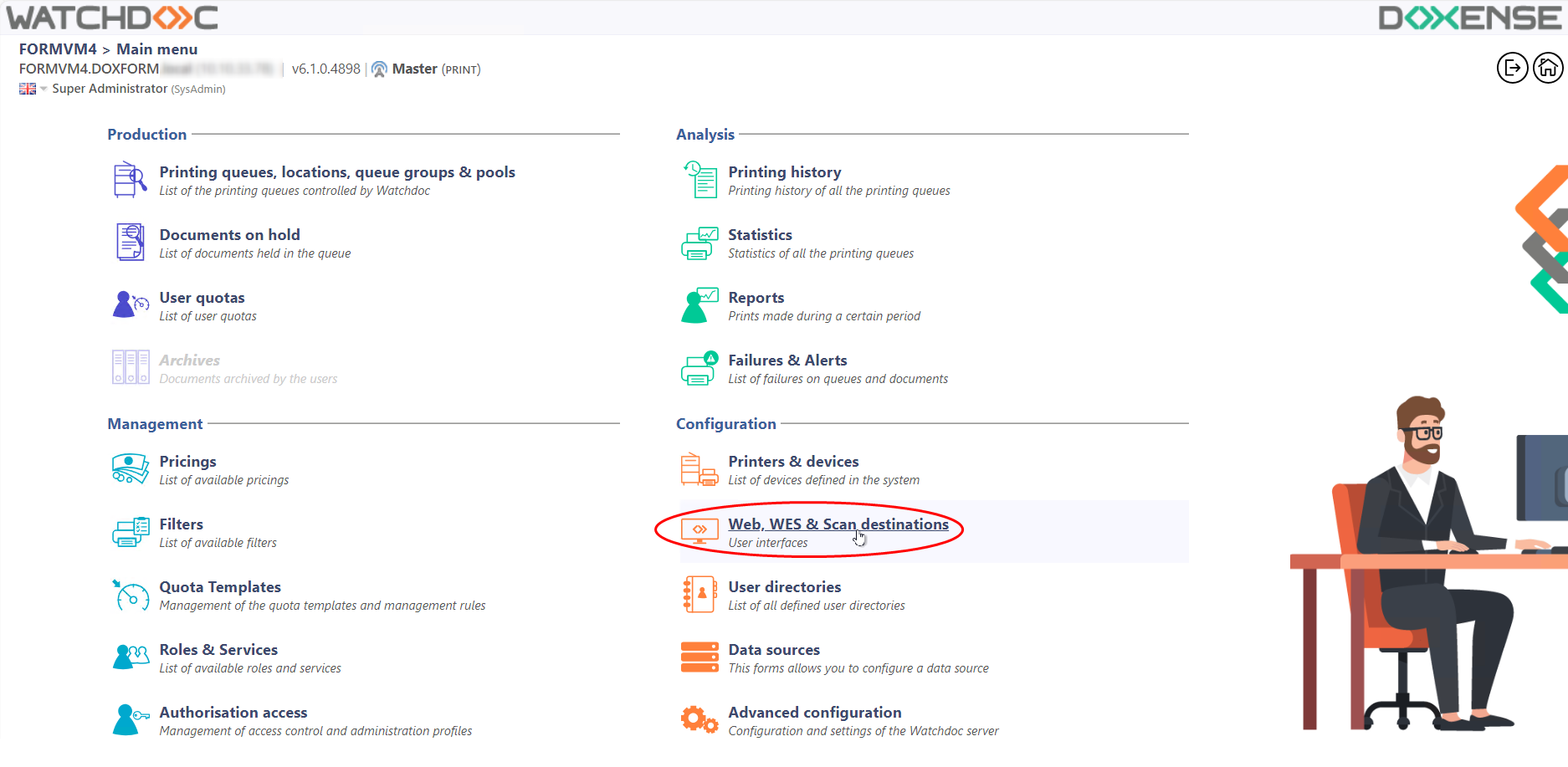
-
in the Web, WES & Scan Destinations - Client Interface Management interface, click on Create a new WES profile;
-
in the list, select the profile you want to create:
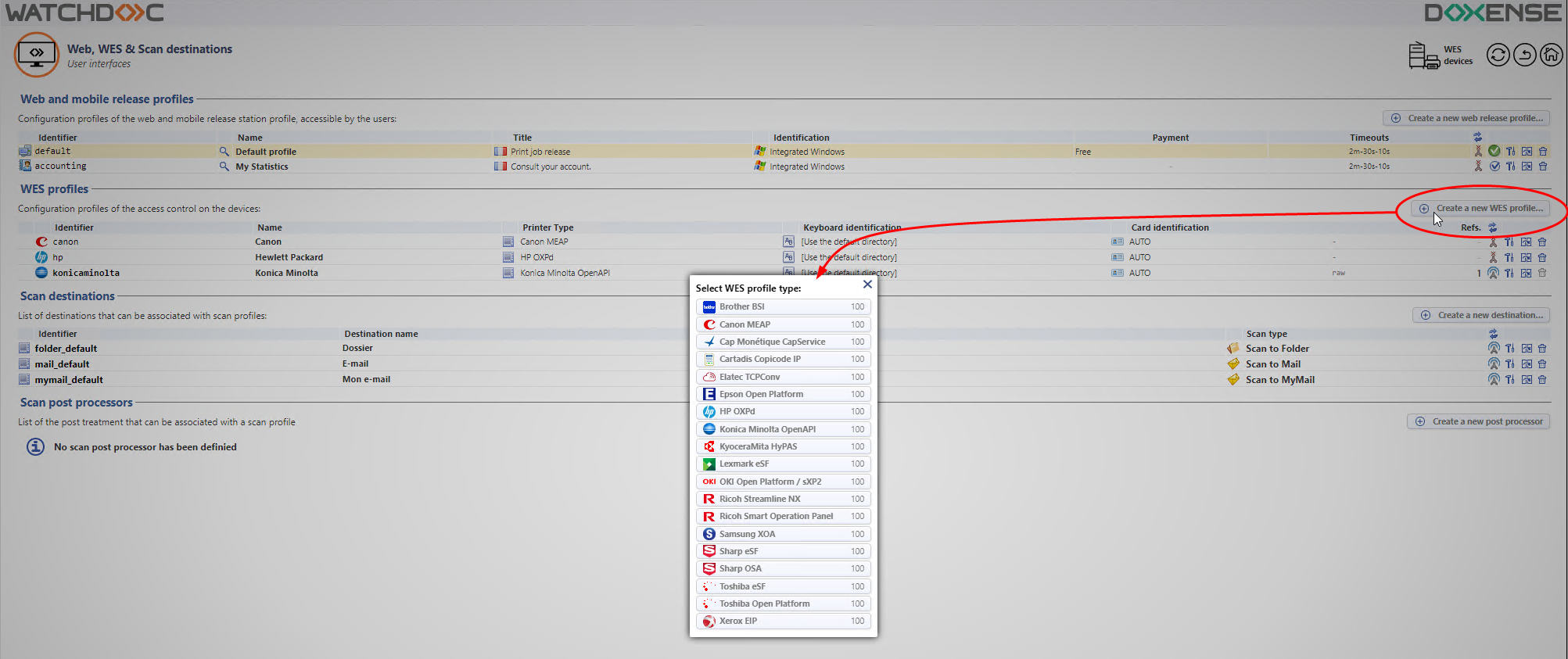
è you will access the Create a WES profile form, which contains a number of sections in which you can configure your WES.
Configure the WES profile
Configure the Properties section
Use this section to state the main WES properties:
-
Identifier: Enter the single identifier for the WES profile. It can comprise letters, numbers and the '_' character with a maximum of 64 characters. This identifier is only displayed in the administration interfaces.
-
Name: enter the WES profile name. This explicit name is only displayed in the administration interfaces.
-
Global : in the case of a master/slave configuration, tick this box to replicate this profile on the slave servers.
-
Language: Select the WES display language configured from the list. If you select Automatic detection, the WES adopts the language it finds by default in the device configuration.
-
Version: select the version of WES. For v3, you can customise the interface by choosing the colour of the buttons and images to match your graphic identity:
-
Colour: enter the Hexadecimal color value corresponding to the WES button's colour. By default, the buttons are Watchdoc® orange customized (#FF901). Once the value is entered, the colour is displayed in the field.
-
Images: if you want to customize the WES images, enter the folder path in which are recorded images you want to display instead of the default images (stored in C:\Program Files\Doxense\Watchdoc\Images\Embedded\Doxense\[Manufacturer_Name] by default).
-
Configure the Authenticate section
-
Mode: from the list, select the authentication mode you wish to activate:
-
Managed by Watchdoc: choose this mode if you want the WES to manage authentication and rights on the device. By default, this mode is activated on all models supporting the Elatec badge reader
-
Managed by an XSA kit: choose this mode if authentication is managed by a third-party application supplied by Xerox. In this case, the XSA web service must have been activated (see prior configuration) and Watchdoc is then only used for print on demand and accounting.
-
-
Rights management: tick the boxes to authorise authenticated users to access functions on the device:
-
Copy ;
-
Email scan;
-
Other scans ;
-
Print

-
Configure the keyboard authentication mode
-
Keyboard authentication:
-
Enable: tick the box (at the section level) to enable user authentication from a physical keyboard or the touch screen one, then set out how this authentication works:
-
Directory: From the list, select the directory to query during keyboard authentication. If no directory is set, Watchdoc will query the default directory. Then specify how users are to authenticate themselves:
-
Mode: choose one of the authentication mode
Login and password: users will use their LDAP credentials. We do not recommend using this mode.
Login (PUK Code): the PUK code is automatically generated by Watchdoc according to the parameters defined in the directory and communicated to the user on the "My account" page.
Login and PIN Code: consisting of 4 or 5 digits, the user PIN code (1234, for example) is registered as anLDAP attribute or in a CSV file. It is associated to the user login (available with the Watchdoc 5.1 version).
Login and print password: users will use their LDAP login and a code a code specific to the printing function

-
Configure the Accounting section
-
Device > Uses the prints accounting information from the device : tick this box if you want accounting to be supported by the device instead of the Watchdoc parser. This only applies to print jobs. Results are more reliable especially when the job is not fully printed (canceled).

Configure the Quota section
-
Enable: tick the box to enable the WES to manage print quotas.

Configure the analytical codes
In this section, you give users the ability to enter code to assign a code to print-jobs so that their cost can be broken down.
When the option is checked, the solution installed on the device offers the user the option of entering or selecting a billing code for the documents made on the device and for the prints released.
-
Activate option: tick the section box to activate the feature from the WES. In this case, the user must enter or select from a list a billing code to print documents on the device
-
Data source: : in the list, select the source corresponding to the billing codes if there are several. By default, the data source is DS_BILLINGCODES.
-
Deny access if the user does not have the billing code in the source: Tick the box to refuse the printing right to users who haven't billing codes.
-
Display mode: in the list, sélect the value that must be displayed to the user : only the service code, only the service label or both code and label;
-
Display parents: tick the box if you want to display the codes of the parents of the entered code:
-
Search:
-
search scope: when the user does not know the code to impute, he can search on the field "Code", on the field "Label" or on both fields simultaneously.
-
search mode: specify whether the search is for the beginning of the value or part of the value.
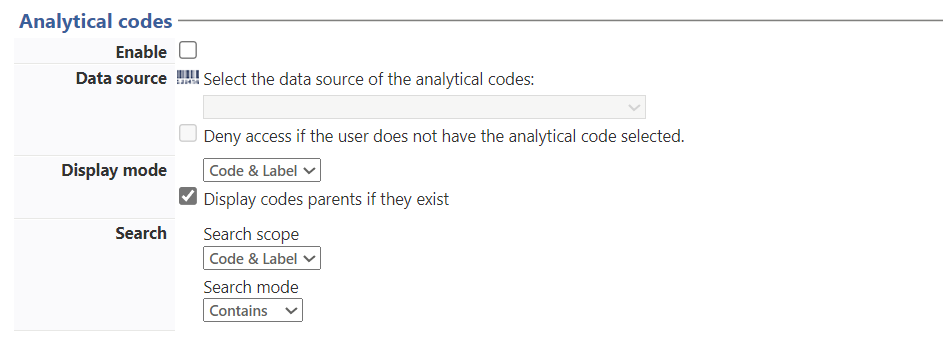
-
Configure the Pull print section
In this section, you can change options about the Watchdoc release application: sort
order of the document, tariff information and optional pages.
You can bypass this application by enabling the automatic release mode. When the user
is authenticated on the device, all its documents are released.
-
Menu icon: to access the interface, the user clicks on the Watchdoc logo. By default, this logo is called My Prints .
-
Label of the application: enter the name you wish to associate with the logo instead of the default name (instead of Watchdoc by default) ;
-
Description of the icon: enter a description giving information about the nature of the application (this information is displayed on the administration website).
-
-
Sort Order: Set the documents order on the device screen:
-
Reverse chronological: More recent documents will top the list ;
-
Chronological: Older documents will top the list.
-
-
Options:
-
Release all documents at login: When the user logs on by swiping his card or typing his PIN code, Watchdoc releases all user documents on the device where he logs on
-
All documents are checket by default: Check the box to ensure that all print-jobs are automatically ticked in the list of waiting print-jobs when the user logs in.
-
Enable Page Zoom: Select this checkbox to enable the user to zoom in on jobs waiting to be printed (PCL 6 driver required);
-
Enable spool edition: tick this box to enable the spool transformation function;
-
-
Display options: monetary information presented to the user Select which information will be displayed to the users (none, cost, price);
-
Force the monetary display to 2 decimal digits: Tick the box to limit the number of decimal digits displayed to the user in the tariff information.
-
Use a custom logo: (WES V2 only) Tick the box to custom the WES by applying your organisation logo. In this case, the logo must be recorded in the Watchdoc server dedicated folder (C:\Program Files\Doxense\Watchdoc\Images\Embedded\Logo.png).
-
Display print policy warrning messages: tick this box if you wish to inform users of the printing policy that has been implemented, which could change their initial choices.
Configure the Scan section
This section is used to configure the WEScan function. It can only be activated with a WES V3.
-
Menu icon: to access the interface, the user clicks on the Watchdoc logo. By default, this logo is called WEScan.
-
Label of the application: enter the name you wish to associate with the logo instead of the default name (instead of WEScan by default) ;
-
Description of the icon: enter a description giving information about the nature of the application (this information is displayed on the administration website).
-
-
Display settings- Use the last values chosen by users: allows the user to be offered the most used scanning profiles (predefined settings), which offers a time saving when scanning uses are often the same. Then specify whether the classification should be done using:
-
the type of profile: (the most frequently chosen profile);
-
the date of use (profile chosen the last time it was used).
-
-
Open default profile bar: provides an interface in which the user can choose between all the scanning parameters, which is useful when the scanning uses are very varied. Then specify whether you want to display the settings or the (pre-set) profiles.
-
the scab settings type ;
-
the scan profile type (pre-configured).
-
-
Allow users to switch display modes: tick this box to allow the user to customize their interface by choosing their preferred display mode.
-
Scan profiles: for each profile listed, you can check:
-
activation: to make it active in the embedded interface;
-
inheritance: to allow the user to create a new profile inheriting the parameters of the existing profile. The user will then be free to modify one or more parameters of the original profile;
-
destinations : the destination is the place where the scanned document is sent. For each profile, you can activate, deactivate and define one or more destinations by default:
-
E-mail: Send the scan to the e-mail of a recipient entered in the interface;
-
My e-mail: send the scan to the user's email (always known if the user has an AD account);
-
Folder: send the scan to a predefined folder in the workspace accessible to the user.

-
-
Configure the Device section
This section is used to define the connection mode between the server and the print devices.
-
Server Address type: The device needs to contact the Watchdoc server when the user tries to connect or wants to release his documents. You can specify the Watchdoc server address in three different ways: IP Address, DNS Address and Custom Address ;
-
Jobs: specify, in minutes, the time during which print jobs are retained in the event of suspension.
-
Network - Port SOAP: if the device connection settings are not the default settings, specify the device access port number.
-
Use SSL to display Web Pages on the device: tick this box to secure web pages displayed on the device screen;
-
Use SSL for SOAP requests: check this box to secure SOAP requests used to configure the device ;
-
Lockout: from the list, select the appearance of the device screen when it is locked :
-
Full: the screen is completely locked, the application icons are not visible and no application is freely accessible, the user being asked to log in first.
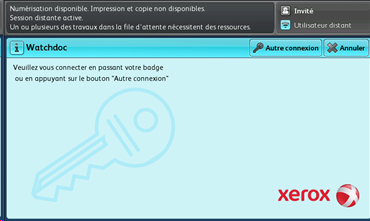
-
Services: all applications are locked, but their icons are visible.
-
Sélectif: you can select which applications will be locked (ticked box) and which will be freely accessible (unticked box):
-
Copy: gives access to the function of copy;
-
ID Card Copy: gives access to the function of ID card copy that allows the user to photocopy both sides of an ID card or small document onto a single sheet of paper.
-
Scan to email: gives access to the function of scan and send to an e-mail address;
-
Scan to folder: gives access to the function of scan to a folder;
-
Scan to USB: gives access to the function of scan and send to a USB key;
-
Scan to home: gives access to the function of scan and send to a personnal folder;
-
Network fax: gives access to the function of network fax;
-
Internet fax: gives access to the function of internet fax;
-
Fax: gives access to the function of fax;
-
Save for reprint: gives access to the function for saving print jobs in the device's internal memory ;
-
Reprint saved jobs: gives access to the function that allows to print jobs stored in the device's internal memory ;
-
Media print: gives access to the function that allows to print from mobile device;
-
-
Scan to: gives access to the function that offers several ways of scanning and storing a document (to e-mail, to USB media, to a predefined folder, to a network folder);
-
Print from: gives access to the function that allows to print from a device;
-
Device: gives access to the function thant gives information about the device (serial number and model, shop status, invoicing and consumables).
-
Device security: tick the box if you are using the default identifiers or specify the device administrator account (login) and password that Watchdoc needs to communicate with the device for certain operations (automatic installation, SOAP requests, etc.).
Security protocols: In the list, select the protocol activated between the WES and the Watchdoc kernel:
-
Use default credentials: WES automatically adapts to the data communicated: it uses SSL for sensitive data (PUK code, login/mdp, etc.) and not SSL for non-sensitive data;
-
SSL: WES always uses SSL to communicate with the server.
-
TLS: tick one of the TLS boxes to secure exchanges between the server and the device (depending on the TLS version chosen).
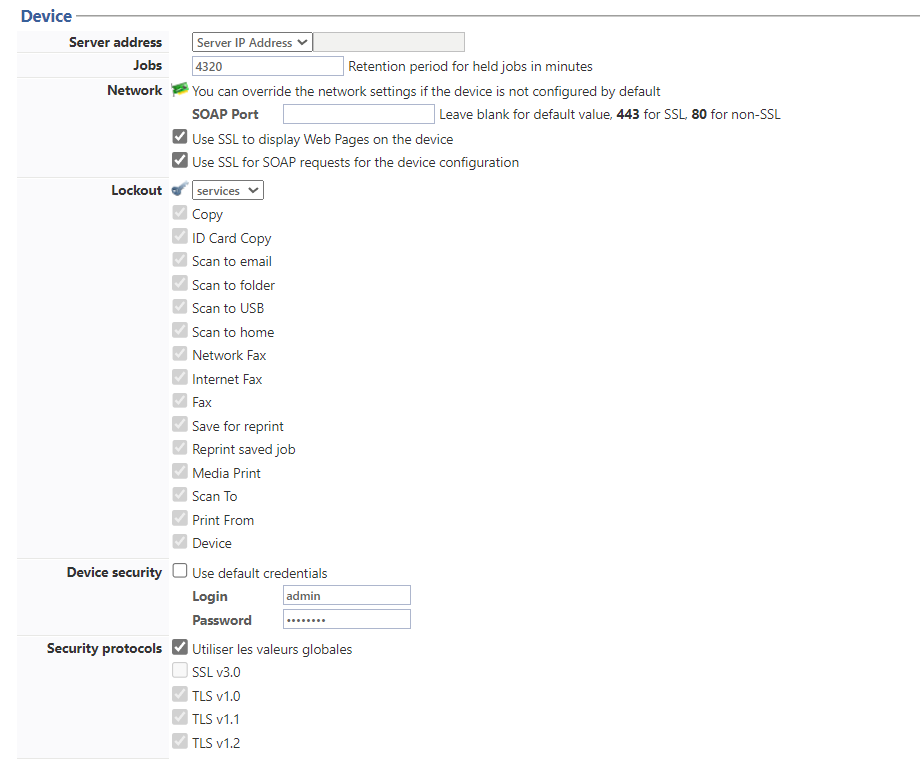
Configure the History section
This section displays information on the configured WES and on modifications made to it :
Validate the profile
1. Click on the button  to validate the WES profile configuration.
to validate the WES profile configuration.
→ Once validated, the WES profile can be applied to a print queue.
